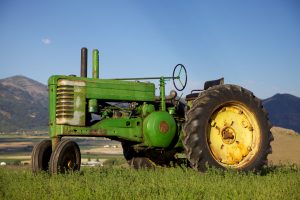 I had intentions on writing up a photo-book story of the restoration process of the John Deere Model A. I’m having a hard time finishing it, so I thought in the meantime, I’d just throw it up here. If there are any major spelling/grammar mistakes or things you’d like added, please use the comments field below. I’ll add some photos later. Click “Continue Reading” below for the full story.
I had intentions on writing up a photo-book story of the restoration process of the John Deere Model A. I’m having a hard time finishing it, so I thought in the meantime, I’d just throw it up here. If there are any major spelling/grammar mistakes or things you’d like added, please use the comments field below. I’ll add some photos later. Click “Continue Reading” below for the full story.
John Deere Model A—The story of one tractor’s restoration
Introduction
Having grown up on a small farm in a little town in Wyoming, I’ve always had a love for farming and the history of what came before. This is the basis for this story. The story is of one piece of history’s journey from its delivery from the factory to where it is now—having found new life and a second beginning. This is a short story of the restoration of a 1947 John Deere model A, with photos and videos accompanying the details of its resting spot and restoration.
A brief history of the John Deere Model A
The John Deere Model A was once a very popular model for John Deere, having been produced from 1934 until being replaced by the Model 60 in 1952. The A was produced as John Deeres first successful row-crop tractor. The A had adjustable tread, which meant the width of the tires could be spaced in or out as to accompany different spaced rows of a variety of crops.
The Model A was a very successful tractor, and was also the tractor that many farmers purchased as their first tractor on the farm—replacing the trust worthy team of horses. The simple two-cylinder design of the A made it very easy for the owners to repair and maintain. This was a requirement at the time, as most farmers would have had little to no mechanical experience beyond working on simple horse-drawn implements and equipment.
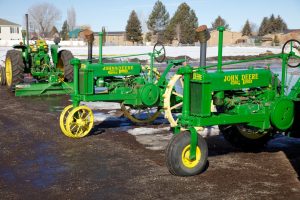 During its 19-year production, John Deere introduced several changes to the Model A. The A saw three major designs during its lifetime. The first was later to be called the “unstyled” model, meaning it was a bare model frame with very little to no sheet metal styling. This model had an exposed radiator and was very basic and simple. The first major revision came in the 1939 model year, which became known as the “early styled” model. This revision included a styled hood and enclosed radiator, and later an increase in horsepower and a change in the transmission, from four to six forward-gears. The last major revision would be introduced in 1947. This saw the frame going from a cast frame to a pressed-steel frame, as well as the introduction of a cushioned seat, which sat on top of the battery box (moving it from behind the hood). This model was also the first that included an electric start and lights as standard equipment.
During its 19-year production, John Deere introduced several changes to the Model A. The A saw three major designs during its lifetime. The first was later to be called the “unstyled” model, meaning it was a bare model frame with very little to no sheet metal styling. This model had an exposed radiator and was very basic and simple. The first major revision came in the 1939 model year, which became known as the “early styled” model. This revision included a styled hood and enclosed radiator, and later an increase in horsepower and a change in the transmission, from four to six forward-gears. The last major revision would be introduced in 1947. This saw the frame going from a cast frame to a pressed-steel frame, as well as the introduction of a cushioned seat, which sat on top of the battery box (moving it from behind the hood). This model was also the first that included an electric start and lights as standard equipment.
The model A in this story was produced in 1947, making it the first year of the late-style.
Birth in Idaho
According to research conducted by the “Two-Cylinder Magazine”, this particular tractor was created on July 23rd, 1947, and shipped to the small town of Downey, Idaho on July 29th, 1947. As for the details of who bought it and what the tractor was used for, I do not know.
Grandpa Purchasing with the B
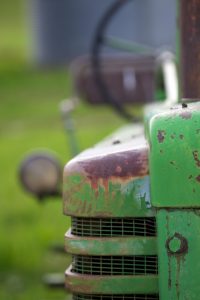 My grandfather purchased this Model A tractor in the 1980s as a bundled deal with a 1949 John Deere B. The B was the smaller sibling to the A. At the time of purchase, the B was running (though needed some minor repairs), but the A was not. Grandpa made the purchase because he wanted a small tractor for odd jobs, but also wanted a two-cylinder for nostalgic purposes. He chose this particular purchase because the B had a wide-front end, as opposed to the narrow tricycle style.
My grandfather purchased this Model A tractor in the 1980s as a bundled deal with a 1949 John Deere B. The B was the smaller sibling to the A. At the time of purchase, the B was running (though needed some minor repairs), but the A was not. Grandpa made the purchase because he wanted a small tractor for odd jobs, but also wanted a two-cylinder for nostalgic purposes. He chose this particular purchase because the B had a wide-front end, as opposed to the narrow tricycle style.
My uncle told me that when they were only using these older tractors on the farm, that grandpa was almost involved in an accident with the tractor tipping over. His farm is a very beautiful farm, nestled up against the national forest. As such some of the hills are quite steep and difficult to farm—even with our modern large tractors. Because of this incident, Grandpa no longer wanted to purchase the tricycle style but instead preferred models with the wider front end for increased stability. The Model B was just that—a Model B but with the wide front end.
Resting in the weeds
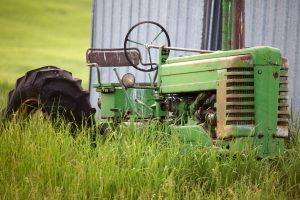 After the purchase, the B was put to use on the old “hay fluffer” (a device used to raise rained-on rows of hay for proper drying) and attached to the grain auger in the fall to load the grain brought in from the fields into the storage bins. While the B was able to enjoy a nice relaxing life with occasional chores, the A just sat where she was unloaded. Although appearing to be a symbol of strength and an icon for the farm and days gone past, she simply rested—and each year the grass would grow tall around her, followed by the covering of deep snow during our long winters. And so this cycle continued, year after year after year. With each passing year the hope of one day plowing through the field becoming ever so faint, as each year brought with it more rust, damaged parts, and only despair as a future.
After the purchase, the B was put to use on the old “hay fluffer” (a device used to raise rained-on rows of hay for proper drying) and attached to the grain auger in the fall to load the grain brought in from the fields into the storage bins. While the B was able to enjoy a nice relaxing life with occasional chores, the A just sat where she was unloaded. Although appearing to be a symbol of strength and an icon for the farm and days gone past, she simply rested—and each year the grass would grow tall around her, followed by the covering of deep snow during our long winters. And so this cycle continued, year after year after year. With each passing year the hope of one day plowing through the field becoming ever so faint, as each year brought with it more rust, damaged parts, and only despair as a future.
Love for the Two-cylinders
Growing up with the B
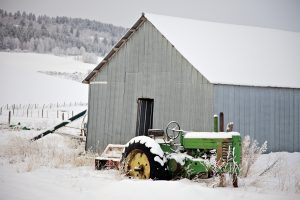 As the A sat quietly in her resting spot while watching the years swiftly pass by, the B and I were spending some good quality time together out in the fields. Where I was just a small child, I was not yet able to take on the larger tasks such as planting, baling, or combining. As such, I was able to spend a good amount of time going up and down the rows of hay with the B in preparation for baling them into the small bales that we once used. Although the B was not as large or magnificent as the more modern tractors at the time, there was a simple joy in running the old small and unsophisticated, two-cylinder John Deere. Hearing the sound of the “put-put” as she glided along the rows, while having images in my mind of my grandfather and great-grandfather running the same fields on a similar tractor, created a type of indescribable attachment and appreciation for the small and meek tractor.
As the A sat quietly in her resting spot while watching the years swiftly pass by, the B and I were spending some good quality time together out in the fields. Where I was just a small child, I was not yet able to take on the larger tasks such as planting, baling, or combining. As such, I was able to spend a good amount of time going up and down the rows of hay with the B in preparation for baling them into the small bales that we once used. Although the B was not as large or magnificent as the more modern tractors at the time, there was a simple joy in running the old small and unsophisticated, two-cylinder John Deere. Hearing the sound of the “put-put” as she glided along the rows, while having images in my mind of my grandfather and great-grandfather running the same fields on a similar tractor, created a type of indescribable attachment and appreciation for the small and meek tractor.
Aside from the time I spent on the B, I would often pass the A while driving the large modern tractors while heading out to or returning from a long days work out in the field. My mind often came up with images similar to those in Disney’s animated short “Susie the Little Blue Coupe”, with the large and tall new machine eyeing down the rusty old A as it would nearly tower over it as we drove by. Although the large tractor almost seemed to be laughing at it, to me it seemed amazing that in such a short amount of time these machines would change in so many ways, and yet the old A still seemed to show strength in its appearance.
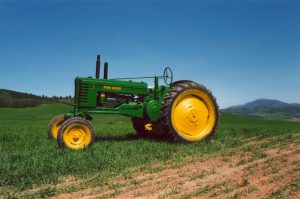 As I grew older and was able to take on more responsibilities, I never lost the fondness for the old John Deere. Although I spent many more hours in the comfort of a large diesel John Deere tractor with a heated and air-conditioned cab, I still tried to make some time to spend on the old B. As we changed the way we farmed and the tasks that were once performed by the B became no longer necessary, the need for the B seemed to be all but forgotten. As I still had a love and desire for the tractor, I was able to take a sense of ownership of the tractor. As such, while I was in high school, I found myself tinkering on the tractor and fixing a part here and replacing a part there. I then painted the tractor, which seemed to bring a spark of new life and a new purpose for existence into the aging B. As my love for the B and interest in the classic John Deere tractors remained strong, so too did my desire to one day restore the mighty iconic John Deere A.
As I grew older and was able to take on more responsibilities, I never lost the fondness for the old John Deere. Although I spent many more hours in the comfort of a large diesel John Deere tractor with a heated and air-conditioned cab, I still tried to make some time to spend on the old B. As we changed the way we farmed and the tasks that were once performed by the B became no longer necessary, the need for the B seemed to be all but forgotten. As I still had a love and desire for the tractor, I was able to take a sense of ownership of the tractor. As such, while I was in high school, I found myself tinkering on the tractor and fixing a part here and replacing a part there. I then painted the tractor, which seemed to bring a spark of new life and a new purpose for existence into the aging B. As my love for the B and interest in the classic John Deere tractors remained strong, so too did my desire to one day restore the mighty iconic John Deere A.
The Calendar
I’ve always had a love for photography. Having the fortune to live in a beautiful area and on a beautiful farm, the farm is often the subject of much of my photography. Also being someone that’s technically gifted, many of those photos end up online on either my own personal webpage or floating about somewhere else on the Internet.
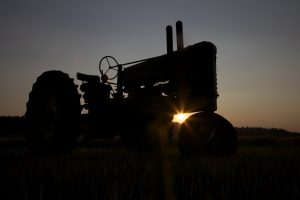 In 2008, I was contacted by a representative from John Deere about possibly having our farm as one of the months in the 2009 John Deere calendar. They were impressed with the pictures I had posted on my website, both of the machinery and also of the location. The theme for the 2009 calendar was “Throughout the Generations”. In qualifying for the calendar (as there were many more farms that were selected than there are months in the year), I had to come up with several historic photos of the farm, as well as recent ones that I’ve taken throughout my lifetime.
In 2008, I was contacted by a representative from John Deere about possibly having our farm as one of the months in the 2009 John Deere calendar. They were impressed with the pictures I had posted on my website, both of the machinery and also of the location. The theme for the 2009 calendar was “Throughout the Generations”. In qualifying for the calendar (as there were many more farms that were selected than there are months in the year), I had to come up with several historic photos of the farm, as well as recent ones that I’ve taken throughout my lifetime.
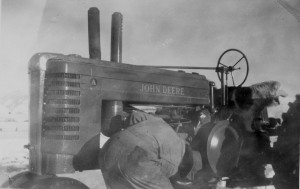 I was very fortunate that I have a great-aunt (my grandfather’s sister) that took many photos when she was a young girl while growing up on the farm. I contacted her and asked her if she had some good farm photos still available that I could use as part of the submission for the calendar. Fortunately, she had some great photos of the original tractor on our farm—a strong and proud John Deere model A. I not only had the privilege of receiving some great historic photos, but also had the privilege of hearing some good stories from a very kind and energetic lady.
I was very fortunate that I have a great-aunt (my grandfather’s sister) that took many photos when she was a young girl while growing up on the farm. I contacted her and asked her if she had some good farm photos still available that I could use as part of the submission for the calendar. Fortunately, she had some great photos of the original tractor on our farm—a strong and proud John Deere model A. I not only had the privilege of receiving some great historic photos, but also had the privilege of hearing some good stories from a very kind and energetic lady.
We ended being one of the selected finalists, and our farm was featured in the 2009 John Deere calendar under the month of April. It was a fun achievement and created pride in the family to be featured in something so close to John Deere.
Original A Photo & Story
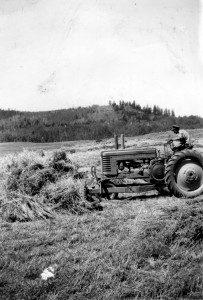
Why did I mention the story about getting into the John Deere calendar? Due to the work and effort of finding the photos for the calendar, there were several very old reoccurring photos of one specific tractor. I could tell from the photos that this tractor was an early styled Model A, but beyond that bit of visually acquired knowledge I knew nothing more about the machine.
One of the greatest things about the Internet is the great connection and community that exists for any topic imaginable. There is some very informative and helpful classic John Deere online communities that I turned to several times for information. After discussing many times with people in these groups, we came to the conclusion that the tractor was a 1940 John Deere Model A.
I later visited again with my great-aunt about the tractor. I informed her of my findings, and she said that sounded about right—that she was in high school at the time and remembers her father purch
asing the tractor new. “Daddy sure loved that little tractor,” she told me while explaining how the year sounded correct. “Daddy had that tractor for a long time,” she said as to exemplify his fondness for the machine. This was the very first tractor that we had on our farm. It was purchased new; I can only imagine the pride and joy my great grandfather would have had in his new product that was about to revolutionize his every-day life. This is the tractor that replaced the horse. I would love to find out what happened to that original tractor, but where grandpa has passed away I believe that to be a bit of information I shall never know.
I probably will never find out what happened to that original tractor. But, there was one thing I did know. There was the old A, still sitting in the weeds, that while not our original tractor, was there begging for some attention. Although it was not the original A, it was the original farm tractor in my child fantasies. It was here, and I had it. I wanted it to run again. The decision was made.
Restoration Process
The Rake
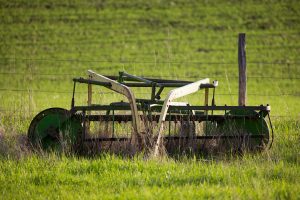 Although the decision to restore the A had been made, it was the restoration of an old rake that was the true catalyst for the actual restoration process. On our farm, next to the “old house”, was an old John Deere side delivery rake. At one time my childhood friend and I thought it would be fun to pull it around with an old Honda Big Red three-wheeler. Needless to say—it was so sunk into the ground from being parked in one spot for so many years that we never did have any success.
Although the decision to restore the A had been made, it was the restoration of an old rake that was the true catalyst for the actual restoration process. On our farm, next to the “old house”, was an old John Deere side delivery rake. At one time my childhood friend and I thought it would be fun to pull it around with an old Honda Big Red three-wheeler. Needless to say—it was so sunk into the ground from being parked in one spot for so many years that we never did have any success.
In the spring of 2011, I thought how it would be fun to restore the old rake and pull it behind the B. I thought how pretty it would be to have a matching implement to the B, and how together the pair would make for a good photography subject. I was correct—although the project would take a little more work then I had originally anticipated.
I remember taking the aging and tired John Deere 3020 down to the rake with the intent on bringing her down to fix her up. The 3020 is equipped with an old style Farmhand loader, which shows the years through its many welded repair lines and cracks. Using the loader, though, on this old and small piece of equipment, I was easily able to uncouple the tight grip of the earth and slowly lift it into the air. After I put it back down, the hitch was now at a proper level, and I was able to hook it up to the 3020 and drag it home, which is a literal statement given the old tires could no longer hold air, nor would any of the ground-driven parts give to any form of movement.
Being the somewhat obsessive compulsive person that I am, I found that, although the rake required a good amount of work and time to become functional again, it was not long before she was running smooth and shining with a fresh coat of paint. This dedication to a project not only helped me learn how easily and quickly I can accomplish a complex task, but also proved to be quite useful in the restoration of the tractor.
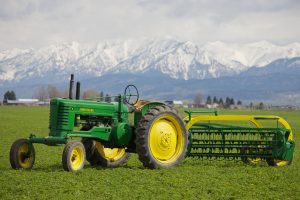 Matched up with the Model B, the pair makes for an impressive display, and has been the subject of many of my more popular photographs, as well as being featured in the popular parts catalog “Steiner Tractor Parts Magazine”.
Matched up with the Model B, the pair makes for an impressive display, and has been the subject of many of my more popular photographs, as well as being featured in the popular parts catalog “Steiner Tractor Parts Magazine”.
Dragging Her Home
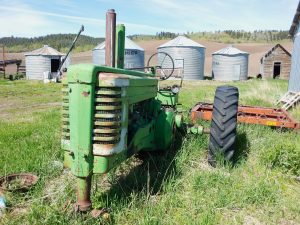
It was a beautiful day in June of 2011. I was visiting with a friend about how it would be fun to pull the A down and finally start working on it. This same friend also helped me restore the rake. Having had some experience bringing an old piece of equipment to life, we thought it would be fun to attempt to do the same with the A.
With the help (more so curious observers) of two of my sisters, we once again took the 3020 and a chain down to the old sleeping A. The front tires were no longer on the tractor, and the front end was supported by a partially sunken cinderblock. We put the chain around the front axle, which attaches to the non-existent wheels. With little effort the 3020 was able to lift the front end of the old tractor off of the cinderblock support. I backed up the 3020, thinking it would easily nudge the tractor forward and onto the dirt road which sat about five feet in front of the tractor. To my surprise, this was not quite the task I had envisioned. The tractor had sat for such a long time that the flat and rotted tires had sunken slightly into the ground. To make matters worse, one of the tires completely refused to even move.
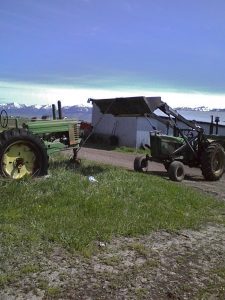
With a little more persuasion and pull from the 3020, the A slowly started to move forward. However, where one of the tires was refusing to turn and where the spring dirt was quite soft, the tractor wobbled forward only slowly while digging quite the trench in the soft dirt.
Now that she was on the road, it was time to pull her home. I live about a half-mile from where the tractor sat, and with the help and pull of the 3020, she slowly started to make her way down the road. The entire trip consisted of the locked-up tire on the side of the dirt road (as it was still making quite the trench along the side of the road), and the other tire wobbling as the rotted rubber slowly turns after being stationary for such a long amount of time. This
constant movement and banging caused the old exhaust pipe to fall right off of the tractor. It was at that moment I realized this was going to be a bit more of a project than I had originally bargained for.
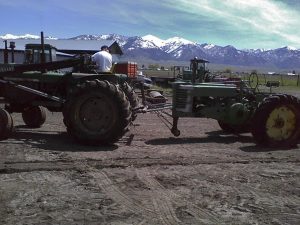
As this entire process seemed to be a little more difficult than I was anticipating, and as such took up more time than I had imagined, we let the tractor come to rest once more on a vacant spot on the farm between where I was currently living and my parents house. I know knew that this was not going to be a very quick or easy task, but in reality something that would take a large amount of dedication and possibly several years to complete. I just left her where she was for that moment—knowing that I needed to give a little thought to the situation before continuing forward.
Ron
Even though the tractor was now closer to home, a few months passed before I really touched it again. We started into haying season (cutting and harvesting the alfalfa crop), and as always, you just get busy. Even though I grew up on a farm, I did not feel I had the mechanical skills that I needed to take on such a project. As such, it now appeared that I took on something that was a bit of a monument and turned it into a piece of junk.
Seeing that I didn’t really know where to begin, I decided to turn to some outside advice. There is another farmer in my town that happens to enjoy the old classic tractors and anything John Deere related as much as I do. Driving past his house, not only do you see his large dairy farm and Deere equipment needed to run such an operation, but his “lineup” of old classic tractors. He has them sitting in a nice long row along the highway—something that is a joy to look at, but also sorrowful to see them all slowly rotting away.
I called this farmer, who’s name is Ron, and asked him if he would come take a look at my tractor and give me some advice on what it would take to get it running again. Ron came a few days later, and brought his “brake freeing device” with him out of his pickup truck, which was a large hammer, and began to eye over the tractor. He stated that the reason the tire would not turn was due to a rusted tight brake, which he attempted to free by tapping with his hammer. This produced no results. He then continued to look over the tractor while we discussed several aspects of its disrepair.
We looked over the main engine block and found it to be in good condition—despite the missing spark plug that now housed a mouse nest in one of the cylinders. The exposed cylinder also meant that the engine was mostly likely locked up from rust and exposure as well, which later I realized was the case. Ron’s final conclusion was that, although it looked like a pretty solid tractor, I was more than welcome to bring it up to his lineup along the highway. It would be able to run again, but it would require a LOT of work.
I was appreciative of his coming over and the advice he gave me. Although there appeared to be a large amount of work to be done, I was still determined to see the old tractor once more purr across a field under its own power.
Setting Up Shop
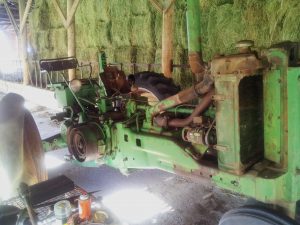 The time had finally come to being the restoration process. There was still one problem though—where should we work on it at? I knew this was going to be a long-term project, and as such it needed to in a place where it would not be too inconvenient to have it and its corresponding parts and tools scattered around. About two years prior, my dad sold the dairy cows. With the cattle gone, much of the barnyard and surrounding areas were now pretty much unused. I decided this would make a good work area—after the removal of the manure, of course!
The time had finally come to being the restoration process. There was still one problem though—where should we work on it at? I knew this was going to be a long-term project, and as such it needed to in a place where it would not be too inconvenient to have it and its corresponding parts and tools scattered around. About two years prior, my dad sold the dairy cows. With the cattle gone, much of the barnyard and surrounding areas were now pretty much unused. I decided this would make a good work area—after the removal of the manure, of course!
Once again, the trusty 3020 loader was put to use moving the A around. This time, however, proved a bit more difficult as we had to maneuver it into a section into the barn where we could work on it and not obstruct other projects. Once we could no longer move it with the loader tractor, we used a cable crank to drag it into position.
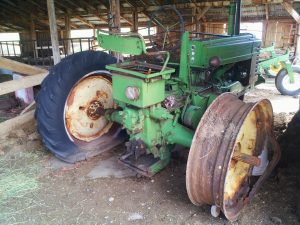 Now, finally, she was in position and ready to begin the slow journey back to life. I took a good look at the tractor, with all the parts that seemed to be falling off and no longer working, and I asked myself: “what have I gotten myself into?” At that time I was almost ready to turn back, but then convinced myself this was a project that didn’t need to be done over night; it was something that could take time to finish and accomplish. It was a project.
Now, finally, she was in position and ready to begin the slow journey back to life. I took a good look at the tractor, with all the parts that seemed to be falling off and no longer working, and I asked myself: “what have I gotten myself into?” At that time I was almost ready to turn back, but then convinced myself this was a project that didn’t need to be done over night; it was something that could take time to finish and accomplish. It was a project.
Tackling what’s wrong—one piece at a time
I knew very little about the mechanical workings of the A. In all reality, I knew very little about being a mechanic in general. Although I grew up on a farm, I was not ever in a position to do any major mechanical repairs. Most of what I had done was limited to fixing broken teeth on diggers and replacing worn out sections on the swather (a machine used to cut and windrow the alfalfa).
That being the case, the process seemed to flow and follow a few logical steps. Examine a piece that’s obviously not working; get it working, and then move onto the next part. An example of this is the wheels not turning. That was an obvious one. Just looking at the long mark along the road makes that one pretty obvious. I initially thought something internal in the transmission was the problem. After a closer examination, I realized the problem was a locked-up brake unit. Although one side could turn freely, the other side could not.
Now that I knew it was the brake that was holding it up, the next step was to disassemble it. I started taking it off, knowing nothing about it. This was not an easy task. Apparently there is a right way of doing it, and a wrong way. The correct way, with pressure applied to the proper spot, once the bolts are removed, makes it come right off. The wrong way is applying pressure to anywhere but the right spot, and spending hours banging on it with a crow bar and hammer to get it off. Needless to say, the voice of experience is an amazing thing.
I’ll mention the hood to give you another example on how experience speeds up the process. The first time I disassembled and removed the hood, I ran into several problems. It literally took a weeks worth of working on it to get it removed. After I learned how to properly remove it (as well as the miracle of penetrating oil), I am now able to remove it completely and expose the engine in less than a half hour.
The main tool used in the restoration process is time. I realized this was going to be something that required a great deal of dedication, and a great amount of time to accomplish. Nearly every day, when I was not at work or home working on the farm, or doing homework while working on my graduate degree, I was in the barn repeating the processes listed above. The more time I spent on it, and the more pieces that were repaired and put back together, slowly but surely started to show results. It was starting to look and feel more like a functioning tractor.
Help from Others
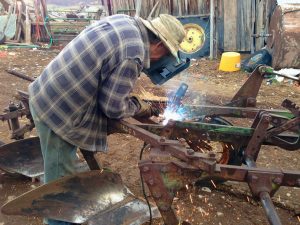 I don’t’ want this story to be a manual on how to disassemble and re-assemble the tractor. Rather, I want this to be about the experience and story of doing so. As such, I won’t go into detail on every part removed and fixed.
I don’t’ want this story to be a manual on how to disassemble and re-assemble the tractor. Rather, I want this to be about the experience and story of doing so. As such, I won’t go into detail on every part removed and fixed.
I want to mention the greatest resource that I found. That resource is the tremendous amount of help from others. I found out that there exists online a large community of others who are engaged in the hobby of restoring old tractors. These people were extremely knowledgeable, and very willing to help. As I would run into problems or something I could not figure out, a quick question to them on the online forums would spawn near immediate and useful results.
I would not have been able to accomplish it without them. Once I was to the point that the motor was running, they would even go as far as to say to upload a video of what it sounds like running, and in return they would give me advice on what adjustments to make and what to change—all from the sounds it makes! I thought they were both incredible and extremely useful! This too reassured me how experience is key. The Internet is an amazing tool in that it not only allows us to find resources, but also once we ourselves are educated, we are able to be a resource to others.
The learning process
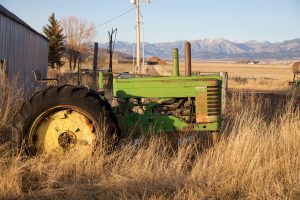 I feel it is important to talk about the learning process. Many of you may be reading this story due to an interest in taking on a similar project of your own. You must know that it is a learning experience. As with learning any new skill, it takes time and dedication. There were times where I was frustrated because I did not understand or know how to do something. I had to remind myself that we aren’t born knowing everything—we have to learn it!
I feel it is important to talk about the learning process. Many of you may be reading this story due to an interest in taking on a similar project of your own. You must know that it is a learning experience. As with learning any new skill, it takes time and dedication. There were times where I was frustrated because I did not understand or know how to do something. I had to remind myself that we aren’t born knowing everything—we have to learn it!
Use all resources that you can find to help learn more about what you are doing. As I just mentioned, the Internet has a great community that can help you to learn. Also, become familiar with parts manuals, diagrams, and other resources that explain what parts are used and how they go together. Read a good book. Although this book doesn’t go into the details of the process, there are many books out there that go into every process that is required, and cover in great detail how to restore and fix major parts.
Again, I turned to the Internet. I found YouTube to be a great resource as well. There are many videos there, which cover a wide variety of repair topics. If you are somewhat technical with computers, once you figure out your own problems you may want to post a video there to help others too. I found that if I was having a problem with something, someone else probably has too!
We are lucky to live in a time where we have so many resources available to us. Don’t be afraid to use them. It will greatly help the process. You can learn from your mistakes, or you can learn from the mistakes of others!
Finding Parts
One thing I realized early on was that this project was not going to be cheap. However, looking back I can see where I spent more money than I had to, and what things I could have done different. The Internet is a great resource for new parts. There are a few companies that specialize in new parts for old tractors.
Not every part or replacement requires a new part. There are some things that you can buy used. However, I found that many of the used parts were not up to the standard I was looking for, and I ended up just getting a new part anyway. Save yourself the time and buy the right part, new or used, to begin with and save yourself some trouble. If you are looking for used parts, be patient. Shop around online, and post some wanted ads in your favorite classifieds. It’s amazing what someone has just taking up space in a garage that they would love to get rid of.
Another thing I realized was that sometimes you can get a complete near-working tractor for almost the same price as a few good new parts. For instance, tires can be very expensive. After doing some searching online I was able to find a complete tractor, with tires, for less than the price of a single new back tire! This tractor also contained many other parts that I was able to use. In fact, this single tractor was a greater parts resource than any other used parts that I had collected before combined. Again, for some things you can’t beat buying a new part, but sometimes it helps to shop around a little and see what’s out there. It could end up saving you a great deal of money in the long run.
First Engine Fire
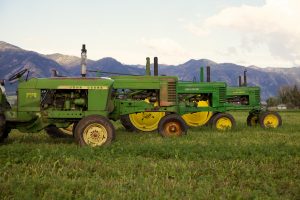 Out of the entire restoration process, the part most memorable and exciting was hearing the bang of the two-cylinder engine as she fired for the first time. The feeling and knowledge of life from the old machine was something I had always dreamed of seeing, and now it was starting to become a reality.
Out of the entire restoration process, the part most memorable and exciting was hearing the bang of the two-cylinder engine as she fired for the first time. The feeling and knowledge of life from the old machine was something I had always dreamed of seeing, and now it was starting to become a reality.
To give an idea of the work that was involved to achieve this small yet important task, I need to step back a bit to when I first started the restoration process. When we first dragged her down and gave it a thorough examination, it was discovered that the engine would not turn over. It was “stuck”. This means that the pistons were rusted tight to the surrounding cylinder wall, and were basically welded into place with rust.
Having done extensive research online, I learned that the best way to “break free” the engine was to use a chemical that dissolves rust, and a large amount of time. I found many references to the statement that “it took a very long time to get it that way, and it will take a very long time to reverse the process”. The task of breaking free the engine included pouring diesel fuel into the cylinders though the spark plug holes, and daily giving it a small rotation on the flywheel. This would put a small amount of pressure on the pistons. Eventually they started to move, but just a little. After many more days I was able to get the engine to do a full rotation, and after some further work the engine was eventually free and turning normally again.
Having the engine turning, however, but just the beginning and a very small part of the process. There was a great deal of carburation and magneto work that needed to be done as well. The magneto is a primitive device used to generate spark for the spark plugs. Fortunately, the Internet once again provided me with the resources I needed to restore and tune these critical components.
Once all of this was completed, the first engine fire really was something of a miracle. At the time I did not know anything about proper timing, the process of making the spark plugs fire when they are at the top of the compression stroke. I really just basically threw everything together, hooked up the rebuilt starter, and turned her over. The tractor did fire, and what a delight it was! It took much more learning and help from others, however, before it was truly running properly.
Even though she was far from running, the slight cough of the engine was enough of a reward to continue on. I knew that, through all that I had been through and all of the work that I had done, that I was truly starting to bring life back into this old piece of farm history!
Finishing up the project
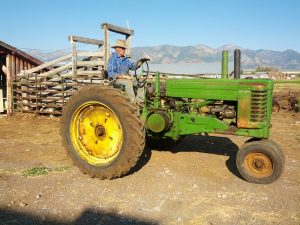 By the fall of 2012, I was basically done with the restoration process. Although the tractor was not painted and still had a few little leaks and problems, she was running much better than I had ever imagined. She fires right up—even better than any of the other old tractors! I had never imagined that within such a small amount of time that it would be running even a fraction as well as it was.
By the fall of 2012, I was basically done with the restoration process. Although the tractor was not painted and still had a few little leaks and problems, she was running much better than I had ever imagined. She fires right up—even better than any of the other old tractors! I had never imagined that within such a small amount of time that it would be running even a fraction as well as it was.
Driving it down the road for the first time was also a very memorable and emotional experience. Having dreamt for so many years of the moment where I was able to drive the old A down the road under its own power, having that moment finally arrive brought an emotion that can only be understood by those who have achieved a long sought-after dream. I’m sure the smile on my face was an outward expression of the emotional joy I was experiencing.
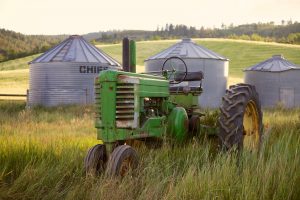 Of course this moment of satisfaction and completion would not have been complete without taking the running tractor to its original resting spot. Approaching the spot where she once stood for so many years, I imagined that if inanimate objects could talk, the tractor and the shed that sat next to its resting spot for all of those years would have had quite the greeting, as the tractor proudly purred as it rolled back into position over where it sat for what it must have thought would be the rest of eternity.
Of course this moment of satisfaction and completion would not have been complete without taking the running tractor to its original resting spot. Approaching the spot where she once stood for so many years, I imagined that if inanimate objects could talk, the tractor and the shed that sat next to its resting spot for all of those years would have had quite the greeting, as the tractor proudly purred as it rolled back into position over where it sat for what it must have thought would be the rest of eternity.
Once it was there, I left her idling while I jumped down, and walked around her while giving it a good visual inspection. After eyeing it over for a bit (and letting the fact that she was running at the spot where I saw it for most of my entire lifetime), the next thing to do was to document the occasion. Having my camera with me, I took several photos and a few videos to help remember the occasion. This was an important thing to do, for the tractor in that spot was one of my most frequently photographed subjects. I have a picture of it sitting there for almost every different season spanning over many years, so taking a few photos of it now only seemed fitting.
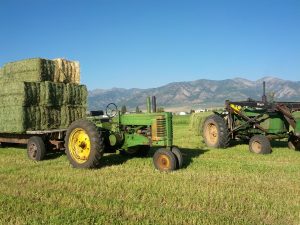 There is one more item to accomplish before the tractor restoration would be considered, by some, as being “complete”. That is the final paint job. I’ve debated on whether or not I should paint the tractor. Having it un-painted gives it a sense of individuality—it’s a visual representation of a hard long lifetime as being someone’s tractor. Many that I talked to gave the impression that leaving it in its “work clothes” gave it more of a story to tell. If you want to see a photo of a perfectly restored John Deere Model A, then a simple online search will give you just that. As you look over and see the photos of the tractor with its faded and rusted paint, I hope you try to see the story behind the faded paint, not just the fact that it’s not “completely restored,” as some may say.
There is one more item to accomplish before the tractor restoration would be considered, by some, as being “complete”. That is the final paint job. I’ve debated on whether or not I should paint the tractor. Having it un-painted gives it a sense of individuality—it’s a visual representation of a hard long lifetime as being someone’s tractor. Many that I talked to gave the impression that leaving it in its “work clothes” gave it more of a story to tell. If you want to see a photo of a perfectly restored John Deere Model A, then a simple online search will give you just that. As you look over and see the photos of the tractor with its faded and rusted paint, I hope you try to see the story behind the faded paint, not just the fact that it’s not “completely restored,” as some may say.
Having to do it over
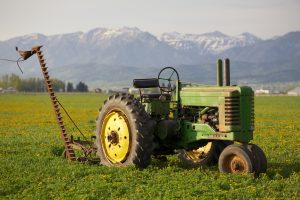 As with most things in life, once something is accomplished it is common to look back and see what could have been done differently, or what changes would have increased productivity or brought about better results. I had a lot of help throughout this entire project from a good friend, and although we learned as we went, we did the best we could for the knowledge we had. Although there were many things that, looking back, I would have done differently, one of the greatest things that I took away from this project was not only the finished project, but also the experiences I learned along the way.
As with most things in life, once something is accomplished it is common to look back and see what could have been done differently, or what changes would have increased productivity or brought about better results. I had a lot of help throughout this entire project from a good friend, and although we learned as we went, we did the best we could for the knowledge we had. Although there were many things that, looking back, I would have done differently, one of the greatest things that I took away from this project was not only the finished project, but also the experiences I learned along the way.
Of course, if I was to do this project over, it would have been done faster, I would have known where and what parts to buy, and would not have broken or done several unnecessary things that didn’t need to happen. But, I would be doing it with a vast amount of knowledge that I have now, but did not have then. Although yes, there were better ways of doing things, I’m grateful for the opportunity to do things the wrong way, for those experiences are the things that will help me as I go forward with this and other projects. I’m grateful for the opportunity my 1947 John Deere A gave me to learn and to grow.
Post-restoration
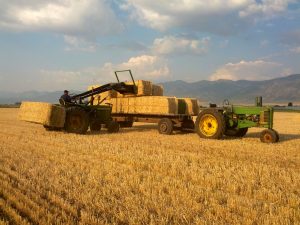 Since the completion of the restoration, I have had several opportunities to use the A doing practical farm work. After the restoration, the next best thing to do to get to know your tractor is to spend some real quality time on the seat! Fortunately, where I live on a farm, last fall it was easy to take a few acres use the A as the tractor assigned to do the various tasks.
Since the completion of the restoration, I have had several opportunities to use the A doing practical farm work. After the restoration, the next best thing to do to get to know your tractor is to spend some real quality time on the seat! Fortunately, where I live on a farm, last fall it was easy to take a few acres use the A as the tractor assigned to do the various tasks.
For those unfamiliar with farming in this area, fall is the time when we harvest the grain (and in our case, barley) and plow the fields. This was fortunate for me, for what better opportunity to have to break in and test a newly restored tractor than to put it to work pulling a load!
A grain crop gives you two products. The grain crop, which is collected together into the bin of the combine, and the stem, which gets laid back down onto the ground as straw. This straw is then baled into either square or round bales. Once the straw is all baled up, the next process is to load it onto wagons and haul it to its destination, which in our case is a storage shed where we store it for use during the wintertime.
I was able to bring in several wagonloads of straw bales with the A. To my enjoyment, the tractor performed beautifully. Although it moved more slowly than a more powerful modern tractor, it performed the task just as well—although with even greater enjoyment and satisfaction. The John Deere two-cylinder engine has a very unique sound, and under a load, the uniqueness of the sound it produces is only magnified. Pulling these slightly heavy wagons it was able to produce this sound, which stated very clearly that this was a very good-running and strong tractor.
After the bales are all moved off of the field, the next thing to do is to plow the field, in preparation for planting it the following spring. Barley is a crop that needs to be re-planted every year, unlike grasses or alfalfa. Needing to plow the little field also gave me another good opportunity to put the tractor under a heavy load and give it a few hours while doing some hard work.
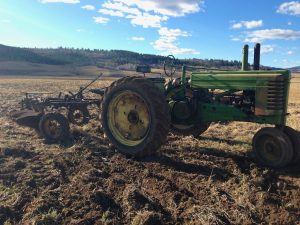 The tractor performed beautifully. I had to find an old plow to use on this tractor (and basically restore it as well), but once I did, I had a very nice matching tractor and implement. Once I had a matching set and working set, I was off turning over the dirt with true two-cylinder power. Being as plowing a field with a small three-bottom plow is a very lengthy process, it also gave me an opportunity to use another old tractor I had been working on to help with accomplishing the task. Together the tractors went round and round, into the darkness of the night, before finishing the job of plowing the entire field.
The tractor performed beautifully. I had to find an old plow to use on this tractor (and basically restore it as well), but once I did, I had a very nice matching tractor and implement. Once I had a matching set and working set, I was off turning over the dirt with true two-cylinder power. Being as plowing a field with a small three-bottom plow is a very lengthy process, it also gave me an opportunity to use another old tractor I had been working on to help with accomplishing the task. Together the tractors went round and round, into the darkness of the night, before finishing the job of plowing the entire field.
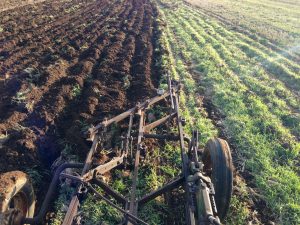 Once again, this was a very fulfilling and almost indescribably joyful task. I never imagined that, only a few short years after dragging the A down the road, I would be sitting on it while plowing a field! Not only that, but the smell of the freshly turned dirt is something that only someone having grown up on a farm can truly appreciate. Mix the two of them together, and you have something that can only be described as something magical to a young farm boy. You see, I was living a process that I had only known of through stories told of being done by my father, but only in his youth, my grandfather, and my great-grandfather. They had all three spent many hours plowing with a John Deere Model A. Although I too grew up plowing fields, it was quite a different experience and procedure than when it was common to do such a task with the A. The feeling was a type of connection to my ancestors, a connection I could feel only having come full circle, going back to the way things were once done but nearly forgotten.
Once again, this was a very fulfilling and almost indescribably joyful task. I never imagined that, only a few short years after dragging the A down the road, I would be sitting on it while plowing a field! Not only that, but the smell of the freshly turned dirt is something that only someone having grown up on a farm can truly appreciate. Mix the two of them together, and you have something that can only be described as something magical to a young farm boy. You see, I was living a process that I had only known of through stories told of being done by my father, but only in his youth, my grandfather, and my great-grandfather. They had all three spent many hours plowing with a John Deere Model A. Although I too grew up plowing fields, it was quite a different experience and procedure than when it was common to do such a task with the A. The feeling was a type of connection to my ancestors, a connection I could feel only having come full circle, going back to the way things were once done but nearly forgotten.
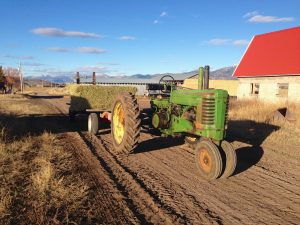 After the plowing was done, the final farm-related activity that was done with the A was feeding the beef cattle. During the fall and winter, the beef cattle are fed daily, as the ground is covered with snow from the months of November through April. As you can imagine, this area has very long winters, and without being fed daily, the cattle would quickly starve. Until the snow came, the A was a very useful and handy little tractor in assisting with the feeding process. Once it snowed, however, the ground became too slick for the tractor to be able to pull the wagon loaded with hay over the steep fields to where the cattle were feeding for the winter.
After the plowing was done, the final farm-related activity that was done with the A was feeding the beef cattle. During the fall and winter, the beef cattle are fed daily, as the ground is covered with snow from the months of November through April. As you can imagine, this area has very long winters, and without being fed daily, the cattle would quickly starve. Until the snow came, the A was a very useful and handy little tractor in assisting with the feeding process. Once it snowed, however, the ground became too slick for the tractor to be able to pull the wagon loaded with hay over the steep fields to where the cattle were feeding for the winter.
Closing thoughts
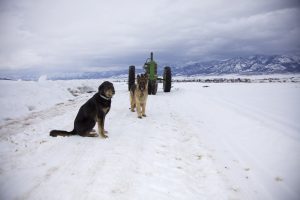 There are two others that had a tremendous contribution that deserve being mentioned. This story would not be complete without them, as they were just as important and included in every single aspect of this project as any other factor. These two were there every step of the way. Every bolt that was turned and piece adjusted, they were there to watch it happen. I say watch because, well, that’s all they could do. I could not have done it without the watchful eyes and company of Dusty and Tip, my trusty and loyal dogs! Even though at times they seemed a little bored, they remained there by my side, waiting till the moment when I would throw a stick, or we moved on to something a bit more entertaining.
There are two others that had a tremendous contribution that deserve being mentioned. This story would not be complete without them, as they were just as important and included in every single aspect of this project as any other factor. These two were there every step of the way. Every bolt that was turned and piece adjusted, they were there to watch it happen. I say watch because, well, that’s all they could do. I could not have done it without the watchful eyes and company of Dusty and Tip, my trusty and loyal dogs! Even though at times they seemed a little bored, they remained there by my side, waiting till the moment when I would throw a stick, or we moved on to something a bit more entertaining.
Although the restoration process is nearly complete, the story of the A is far from being over. Although the tractor will never be the primary source of power or a major requirement on the farm, it will still have its place, giving wagon rides over the farm, the occasional peaceful tractor drive, and the job that is best completed with a small tractor.
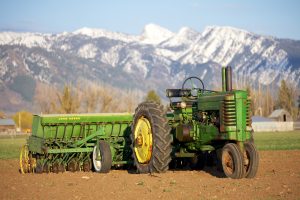 Regardless of what happens, I’ll always be proud of my little tractor. As the years will continue to race on and most people will have long forgotten the restoration process, I will always remember the experience in bringing back to life the tractor that made a young boy wonder just what farm life used to be like; a time that had all but seemed forgotten. The tractor will always remind me of the result that can come from hard work and dedication, as well as the patient companionship of two cherished little four-legged helpers.
Regardless of what happens, I’ll always be proud of my little tractor. As the years will continue to race on and most people will have long forgotten the restoration process, I will always remember the experience in bringing back to life the tractor that made a young boy wonder just what farm life used to be like; a time that had all but seemed forgotten. The tractor will always remind me of the result that can come from hard work and dedication, as well as the patient companionship of two cherished little four-legged helpers.
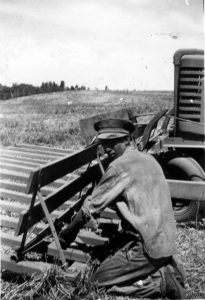
13 responses to “The Story of the A”
That was all inspirational and really nice photography. Plus, it took me back to the old days when we had our 1951 Model A that had been dealer-converted to LP gas–my brother still has it and has done a complete restoration! Just a really nice telling of a good story about an American rural legend that is true and whose story is still being written! Best regards, Hugh McKinney, Hosston, Louisiana
Kyle, what a great story ! Well put together and described. I am fortunate to have the 1945 “B” my Dad bought new. I was 5 years old when it was purchased, which tells you how old I am now. We Farmed in Pa. against the Ohio line, 250 acre Dairy farm. That “B” was the only Tractor for many years. Ran every day either hauling manure, or plowing , planting, making Hay. It sat in the barn for about 14 years after my Dad passed with only Summer use pulling a Bush Hog. I finally brought it to where I now live and went thru it . It now gets to go to Parades, and still earn money pulling people loaded wagons at the local Orchard in the fall. Your story bring back a lot of old memories. Thanks—
GREAT article, pictures and thoughts. We too have a couple of old tractors that my dad, myself and my sons work on together ( 49 Cub, another 49 Cub, 45 John Deere A, 49 John Deere B…are our play tractors!) We have others for work! The John Deere’s are by far the most fun… and sound the best… the entire time we are working on them.. I get to hear about the old stories of when my Dad used to ride on them on their farm in Arkansas with his Dad and Grand daddy. GREAT stories.
You did a great job on this! You should print it on to a “Table book” like Walmart sells, etc… then you can hand it down to your children.
Thanks for sharing!
Here are a few other comments I’ve received:
PostPosted: Fri Jun 28, 2013 7:24 am Post subject: Re: Story about my John Deere A restoration
I like it the way it is! I”d rather see one that is in good mechanical/working condition and original paint than one that has just been repainted and not fixed mechanically. Looked at one a few weeks back that looked all shiny from a distance, but up close, they had just painted over rust and dirt and everything. I mean the plug wires, hoses everything was green.
PostPosted: Fri Jun 28, 2013 7:39 am Post subject: Re: Story about my John Deere A restoration Reply to specific post Reply with quote
Nice story and great photos. I would not paint the ole girl…she looks great in her work clothes and adds character to her. I spent many hours on a multitude of “A” John Deere”s as a kid. I have a pristine 1958 John Deere 630 that looks better than when it came out of the factory. However it is a “Tractor Queen” that only comes out on sunny days and never gets in the mud or near any brush or trees…kind of like a “trophy woman”, great to look at but not much use around the ranch, plus they are high maintenance. Keep up the good work.
PostPosted: Fri Jun 28, 2013 8:20 am Post subject: Re: Story about my John Deere A restoration Reply to specific post Reply with quote
Kyle great story !!!! I my self would not paint it either. I have a
44 handstart A that if it wouldn’t have been painted before I got
it I would have also left it alone. Fixed what needed to be fixed
and then used it. Great photos too !!!! Good job on getting
breathing again.
PostPosted: Sat Jun 29, 2013 7:10 am Post subject: Re: Story about my John Deere A restoration Reply to specific post Reply with quote
Very good story. Good to see that such a young person is so interested in JD old iron, agricultural, local, and personal/family history.
On top of that, lives in a beautiful, scenic area and is into photography and computers.
The world could use a lot more people like you.
Thanks for sharing Kyle.
PostPosted: Sat Jun 29, 2013 11:14 am Post subject: Re: Story about my John Deere A restoration Reply to specific post Reply with quote
Kyle, Great story and videos. I have a 1945 hand start model A that I am working on. What size are your rear tires? I have some other questions, so would you mind emailing me direct @
Thanks
Ray
PostPosted: Sat Jun 29, 2013 12:54 pm Post subject: Re: Story about my John Deere A restoration Reply to specific post Reply with quote
that’s one of the coolest things I’ve seen in a while, good work.
That was a great story and restoration. I grew up on the old JD’s and still love them. I am a model #40 nut, but now own a Kubota.
Good story but you’ve spelled “baling” as “bailing” near the beginning of your story in two locations. You’ve got it correct near the end. Just Fyi. No offense. I’ve got a 1940 B and I know exactly how you feel in your writings. Don’t paint it!
None taken! Thanks for the help, which is one reason why I put it here 🙂 I thought it’d be fun to put it on iBooks or Amazon as a picture book, but everything needs to be correct before I can do so!
Your dedication and perseverance is incredible. The story behind the restoration is intriguing and I’m glad you took the time to post on your website. Be sure to print it off as part of your journal!
I don’t know if it was a mistake or typo, but in the first sentence under ‘The History of the Model A’ it was first produced in 1934 not 1937.
Thanks for catching that! I knew it was 34, so I’m not sure why I put that… It’s been changed 🙂
That was a great read, Kyle. Nice work!
Kyle I’m restoring my Gramp 1950 B. Your story gave me strength . love it
That’s awesome! You will be glad you did! Best of luck!